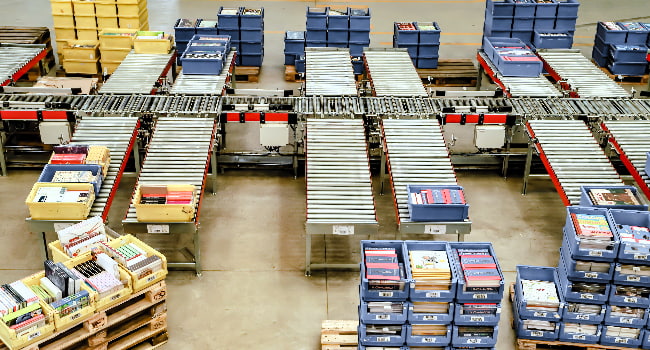A1 Quality Logistical Solutions

- By Haley
- July 10, 2025
Table of Contents
Key Highlights
- One piece flow and batch processing represent two distinct methodologies in warehousing, each with unique process structures and efficiencies tailored to varied logistics operations.
- One piece flow emphasizes streamlined order fulfillment with reduced inventory management complexity. In contrast, batch processing focuses on high-volume processing for maximum cost savings.
- Both workflows directly influence shipping costs, customer satisfaction, and the overall performance of supply chain systems.
- Selecting the right workflow depends on factors like order volume, inventory levels, and customer demand.
- Advanced warehouse management software and logistics technology play critical roles in optimizing operations for either workflow.
- Next, let’s explore the fundamental concepts and dynamics of these warehousing workflows.
Introduction
Choosing the right warehousing workflow is key to make the supply chain and logistics operations work well. There are methods like one piece flow and batch processing. To get the best results, you need to know the good sides and problems with each one. These workflows can change how fast inventory moves, affect shipping rates, and can impact customer satisfaction. If a business uses warehouse management systems with good logistics practices, it can help boost work and keep delivery times steady. Now, let’s look at how the two workflows stack up, and find out how to match one to your operations to get the most from it.
Understanding Warehousing Workflows in the United States
The logistics industry in the United States relies on good warehousing workflows. It is where goods be stored, managed, and delivered. It also helps companies meet changing market needs. The world of logistics changes all the time, so companies need plans that work for different customers and business goals.
Workflows like one piece flow and batch processing are very important to this. These ways of working help make everything run smoothly. They also help with better inventory management and smoother supply chain operations. This is what helps companies in the logistics industry not just compete but stay on top.

Key Objectives of Modern Warehousing
Modern warehousing has a big part to play in making sure customers are happy. Warehouses be sure that deliveries go out on time and are right. When they know what their customers want, they can keep the right amount of goods in stock. This helps meet demand while also staying away from having too much on hand.
Saving money is also very important. Good workflows cut down on extra labor costs and help businesses get the most out of what they have. When companies do this, their bottom line gets better. It also lets them grow when they have to.
Controlling inventory is key for good warehousing. When there is good forecasting and inventory levels are just right, it can stop losses. It also keeps the supply chain working well and makes it easier to restock what is needed. So, when these cost-saving steps come along with better ways to do things, modern warehousing ends up more efficient. This boosts profit and puts the customer first at the same time.
Now, let’s look at how e-commerce and stores shape what is needed in warehousing right now.
The Evolving Demands of E-commerce and Retail
The fast rise in e-commerce has changed how warehouses work. They need to fill customer orders quickly and get things right every time. This is important for a good customer experience. Warehouses have to deal with many types of orders and must also be fast to keep people happy.
At the same time, retail businesses must find ways to deal with changing amounts of inventory. They have to keep up with last-mile deliveries, work with logistics providers, and manage returns. When they do all of this, they can meet high customer expectations and make day-to-day work less stressful.
Warehouses that look forward often use workflows that can grow or shrink as needed. This helps them keep up when there is a rush, like during holiday shopping. This also helps them handle the normal ups and downs of day-to-day sales. Growth in e-commerce and retail makes people look at how well a warehouse can change and handle what comes at it.
Up next, we will talk about the steps of one piece flow.
What is One Piece Flow?
One piece flow is a way to improve the supply chain by sending one item at a time through every step. This makes order processing and inventory management better. It stops slowdowns and helps the work in logistics operations move faster.
With this method, order fulfillment does not get interrupted, and less stock builds up. At the same time, the shipping process speeds up. Warehouse teams can spot and fix problems easily when they use one piece flow. This leads to a smooth system, where things move the right way through the supply chain.

Definition and Explanation
One piece flow works by having a single point of contact for order processing. This helps products move smoothly through every step in the fulfillment process. Because of this, supply chain management gets easier and the logistics operations run more simply.
Batch workflows create extra stock by waiting for orders to pile up before processing. One piece flow is not like that. It uses much less inventory at a time. This means stock levels stay low. You can get products out faster, lead times drop, and resources are used better. For time-sensitive work, this gives people a big advantage.
If a business uses this method, it can focus more on what the customer wants. One piece flow uses a simple and efficient supply chain. By using this for the right demand or order, you meet requirements well.
Typical Applications in Warehousing
One piece flow is used often in warehouses where there is a need for speed and high accuracy in shipping logistics. This way of working is usually found in small and medium-sized distribution centers. These centers focus on orders with lower volumes and put a strong focus on inventory management and order details.
1. Warehouses that need to ship out orders fast, or that deal with time-sensitive products, see a big benefit from using this method.
2. Places where there is not much stock on hand, and where staff must be careful with inventory management, will get the best results with one piece flow.
3. This way of working also helps where orders must be customized or need a close watch on order details.
In the end, using one piece flow helps the warehouse to beat customer expectations for speed and doing tasks right.
Key Characteristics of One Piece Flow
This process needs people who are skilled at their work. They must keep things moving fast and make sure every order is done right.
To get things to people quickly, there can’t be many shipping delays. It helps if you keep stock levels just right. Having too many items on hand can mess up how things run.
All these things work together to make the process lean and smooth. It works best in places that need to be quick and careful. Now, let’s talk about the other system—batch processing.
What is Batch Processing?
Batch processing means grouping orders or tasks together to handle them in bigger loads. This helps make things more efficient. It is often used in high-demand logistics services. This way, warehouses can meet changing needs, and inventory management stays under control.
This method works well for companies that need to save money and have low costs in long supply chains. If your business sells many different things, it is very good for handling different sales channels at the same time. It gives you a level of efficiency that is hard to beat.

Definition and Explanation
Lean warehousing is a way for businesses to make warehouse operations better. It tries to cut out waste and give more value to both the company and the customer. This is done by getting rid of things that do not help and by making inventory management systems stronger. Using new technology and good warehouse management software helps keep better control of inventory levels and makes the fulfillment process smoother.
With lean warehousing, logistics operations also become easier to manage, which lets companies see more clearly into their whole supply chain. In the end, this helps create a good customer experience and gives a boost to the bottom line of the business.
Common Uses in Warehouse Operations
Efficient warehouse operations use different methods to meet the needs of each type of product or order. One-piece flow works well for fast-moving items that need quick and accurate order fulfillment. This method helps to get goods to people quickly. On the other hand, batch processing is great when there are lots of orders to handle at the same time. This way, you can keep track of inventory better and lower shipping costs. Batch processing can help ecommerce retailers make the best use of their storage space and handle changing stock levels with ease. Both ways have important roles in the bigger supply chain. Using them in the right way makes logistics operations run better and helps grow customer satisfaction.
Core Features of Batch Processing
Batch processing helps make operations simple and smooth. It lets you handle many customer orders at once. This way, you get to save money on labor costs for each unit, and you get better at inventory management. You can keep stock levels steady and know what to expect. The process helps with supply chain work because scheduling is easy. You can assign resources to different tasks without much trouble.
When you use batch processing, there is a lot of predictability. This makes it easy to run logistics operations and make sure customer orders go out on time. Advanced warehouse management systems give you better control of the fulfillment process. This means a business can do a better job and give good service to people, all while managing labor costs, stock levels, and other parts of supply chain work.
Comparing One Piece Flow and Batch Processing
A direct comparison between one piece flow and batch processing shows some big differences in how things work in a warehouse. One piece flow keeps things moving all the time. This helps increase supply chain visibility and makes the fulfillment process faster. It also lowers inventory levels and helps the company react quicker to what customers want.
Batch processing, on the other hand, puts many orders together at once. This can be good for big orders and may make some logistics operations more efficient. But this way can sometimes cause errors within the batch and can lead to longer wait times for customers.
One piece flow often supports better inventory management and gives people more up-to-date knowledge about the supply chain. It also can improve customer service. But batch processing can help companies plan their schedules and use their resources better.
To get the best out of your inventory management, it is important to know these differences in supply chain methods and how they affect the way you work.

Differences in Process Structure
Batch processing means that groups of orders are handled and sent out together. This can help with bulk handling and good inventory management. The way it works can make better use of resources, especially in places with steady demand. It can also help to make the fulfillment process smoother by following planned schedules.
On the other hand, one piece flow is when each item moves through the workflow by itself. This can help make supply chain visibility better and help people respond faster. It lets teams make changes right away and can give faster shipping logistics.
Choosing between these two ways can change how well things run, how storage space is used, and how well companies can handle different customer orders.
Impact on Inventory Management
Effective inventory management is very important in warehouse operations. This is true when you look at one piece flow and batch processing. With one piece flow, inventory levels stay lower. This helps keep track of items in real time and lowers stock levels. All of this is good for supply chain visibility. On the other hand, batch processing can mean you have more items piled up. This can hurt how much cash is on hand.
It is important to keep an eye on shipping costs and labor costs as you change the way you do order fulfillment. How you manage these things changes how well your supply chain works and how happy your customers are. So, business owners need to look closely at their inventory management process. The approach they choose can have a big effect on how their warehouse runs and on customer satisfaction.
Speed, Flexibility, and Responsiveness
Making warehouse operations faster will help make all parts of the supply chain work better. Focusing on one piece flow helps to remove slow spots. This makes the fulfillment process smoother and faster. For ecommerce businesses, being able to change and handle different customer orders is very important. Lean warehousing lets a business quickly change how it uses inventory management. This keeps stock levels where they need to be.
When companies are quick to respond to changes in customer orders, the supply chain operations improve. This gives customers better shipping options and helps orders arrive on time. In the end, better warehouse operations and a good fulfillment process help raise customer satisfaction. It also helps the business make more money and stay strong against others in the same field.
Advantages of One Piece Flow in Warehousing
One piece flow can help in many ways for warehousing work. It cuts down the time you need to fill customer orders. This helps you answer customers faster and makes the supply chain work better. Order accuracy goes up too. The steps are simple, so there are fewer mistakes with orders, and that keeps customer satisfaction high. Tracking your inventory levels also gets easier. You get real-time numbers, so you can make smarter choices back at work. All these things help with cost savings and make the most of resources. That is key for anyone in the logistics industry who wants to keep up with other companies.

Reduced Lead Times
Streamlined order fulfillment helps make warehousing more efficient. This means there are fewer delays in the shipping process. When businesses can respond fast to customer orders, they can increase customer satisfaction. Advanced warehouse management systems help track inventory levels. This gives people quick access to see what stock is on hand and makes shipping logistics go faster. Because of this, lead times get better, and companies can keep shipping costs down and control costs. This has a good effect on the bottom line. Being quick and flexible in supply chain operations puts companies ahead in the logistics industry. It helps them make fulfillment better and gives a good customer experience.
Enhanced Order Accuracy
Using one piece flow in the fulfillment process helps to make order accuracy better in a warehouse. In this way, each item gets picked and packed one at a time. This cuts down on mistakes that happen with batch processing. It lets workers pay more attention to order details, so the chance of shipping the wrong thing goes down.
When you have warehouse management software in place, tracking inventory levels in real time is easy. This ensures every order matches exactly what the customer wants. In the end, this makes customer satisfaction better. It also has a good effect on the bottom line.
Improved Visibility and Tracking
A simple way to handle warehousing can really help companies see and track what is happening in the supply chain. When you use warehouse management software, you get real-time views of inventory levels, order processing, and shipping logistics. This kind of transparency helps supply chain operations run better and can help lower shipping costs.
With advanced technology like electronic data interchange, it is easier for logistics providers and fulfillment partners to talk and share information. Because of these smooth connections, companies can send out clear updates and correct order details, giving customers a better experience. This helps boost customer satisfaction while also making sure the business works well.
Advantages of Batch Processing in Warehousing
Batch processing in a warehouse helps a lot, especially when there are many orders to get through. When warehouse workers can handle many tasks at the same time, things move faster. This way, the per-unit labor costs go down. It also becomes easier for the team to schedule jobs. The company can use warehouse space better and keep down any waiting time. Another thing is that cost control gets better over time. Because order processing is improved, there are more shipping options for people. All these things work together in the supply chain to make sure customers get their packages on time. In the end, this gives customer satisfaction and supports strong supply chain operations.

Increased Efficiency for High-Volume Orders
Handling large orders is a great way to make warehousing more efficient through batch processing. When you group several items into bigger shipments, you cut down on shipping costs. This also helps you use your warehouse space better. With this method, you can have better inventory management because workers pick, pack, and send products together as a batch.
If you use the right warehouse management software, your logistics operations get smoother. You can keep a closer eye on inventory levels and order details. This leads to faster order fulfillment and happier customers. All of these steps help boost the bottom line for ecommerce retailers and logistics providers.
Lower Labor Costs Per Unit
Cutting labor costs for each item is one big benefit of batch processing in warehouses. When you put orders together in big batches, you can make better use of the workers. This helps the team finish tasks with less wasted time. If you focus on large orders, you need less warehouse workers for each piece of work. That can help with cost control. It brings down how much the business spends on labor. It works well, especially when you have steady demand. So, companies can handle their current inventory in a better way. They also get better rates for shipping logistics, which helps them make more money and keep things running smoothly.
Simplified Scheduling and Resource Allocation
Running logistics operations the right way is very important for a good fulfillment process. Batch processing helps with planning schedules by putting the same customer orders together. When warehouse management software is used, it helps to use space and people better. This cuts down on time that would be wasted and helps avoid too many things happening at once. That means warehouse space and the people working are used well.
When the work is shared in the right way among everyone, the entire supply chain gets better. Shipping costs go down a lot with this method. Planning how much space and time you need gets easier, too. This lets business owners handle times when there are either a lot or just a few orders. They can keep customer satisfaction high and make good use of what they have. With management software taking care of these things, the supply chain becomes much more smooth for everyone.
Challenges of Implementing One Piece Flow
Using one piece flow in warehouses brings some clear challenges. The first thing is growth. If the business grows fast or order numbers change often, you might see issues with scaling up. Another problem is using all your resources. This way of working depends a lot on steady demand, so when demand drops, some team members or machines may not have enough to do. Also, to keep the fulfillment process running well, you need to be able to predict what customers will order. When demand goes up and down without warning, it can make things hard for your team. Navigating all of these problems is important if you want to improve your logistics operations and offer better customer satisfaction.

Scalability Concerns
Putting one piece flow into how you run your warehouse can be tough when you try to expand. As there are more customer orders, it can get hard to keep the flow of goods moving without any problems. The process might slow down, and this can cause bottlenecks in how you work. Advanced technology like a warehouse management system is important if you want to control the supply chain and have supply chain visibility while things get busier. On top of that, dealing with all kinds of customer orders can be hard on your resources and may make the fulfillment process more difficult. This can affect how well everything runs and even hit customer satisfaction. So, it is important for the business owner to really look at what their logistics can handle now. They must also think about how things could change as they grow. This is the best way to move up without messing up customer satisfaction or the supply chain.
Potential Underutilization of Resources
Inefficiencies often come up when there is batch processing. This way of working can push up inventory levels, since big production runs may fill warehouse space with stock that you do not need. Because of this, management software might not use labor in the best way. You could end up with too many people during times when there is not much demand. These gaps raise costs and can slow down how quick you get customer orders out. It is very important to balance how you use resources with changes in demand. This will help cut waste and keep logistics operations running well in the fulfillment process.
Dependency on Consistent Demand
For one piece flow systems to work well, there needs to be a steady and predictable demand. If customer orders go up and down a lot, this can break the smooth process. This makes things less efficient and may stop work in the system. Since the model depends on steady demand, any changes can hurt the whole fulfillment process. It can also make inventory management harder and cause shipping costs to go up. Batch processing, on the other hand, can handle big jumps in demand better. It gives a little extra help when things are not steady. To get the most out of one piece flow and keep customer satisfaction high, businesses need to have a good forecast of demand. This helps keep service levels up, too.
Challenges of Batch Processing in Warehousing
Longer lead times in batch processing are a big problem for supply chain and logistics operations. This often brings delays and leaves people waiting, which can hurt customer satisfaction. It is hard to keep up customer service when you deal with large batches, because this can create more mistakes and make it tough to keep inventory correct. Custom orders also add new problems. These orders can break normal ways of working, and it’s not easy for batch processing to change and be flexible. You may get more done with this method when you deal with high numbers, but it’s not good if you need a quick and flexible fulfillment process. The downside is that it slows you down and cuts into how well the whole supply chain works. So, it is important to find a good way to be efficient but still handle these problems for your team. This balance will make logistics operations run better.

Longer Lead Times
Long wait times are a common problem in batch processing in warehousing. This can hurt how efficient the work is and how inventory management is handled. The normal process often needs a lot of work in planning and moving large amounts of products. Because of this, there can be delays from when an order comes in to when it is filled. So, customers may have to wait longer for their products. This can lower customer satisfaction and hurt the overall customer experience. Logistics operations can also become slow and have trouble keeping up when things change. Businesses then have a hard time meeting new demand fast. Making the process simpler can help fix these problems. It can make logistics operations more responsive and help lower costs that come from having too much inventory.
Higher Risk of Errors in Large Batches
Handling a large number of orders at once in warehouse operations can bring big risks. It is easy to make mistakes with order accuracy when many items are being picked and packed together. This can mean items get mixed up or there are problems with the inventory. If this happens, customer satisfaction drops and the cost of shipping goes up. The need to fill high-volume orders can also make people move too fast, which leads to even more errors.
Good inventory management is important if you want to reduce these risks. Keeping careful track of items and using regular checks help make order fulfillment better. When you work in this way, you get better supply chain visibility. The whole supply chain operates more smoothly and efficiently, helping both us and our customers.
Difficulties in Managing Custom Orders
Custom orders can be tough to handle in warehouse operations. These orders often come with different order details, which need special attention. Managing all this means you have to watch inventory levels closely. The use of management software or warehouse management software helps keep order processing right, but fluctuating inventory levels add to the challenge. It is important to watch out, or there could be shipping errors.
When working for many ecommerce brands, the needs in logistics operations keep changing. This means you need a flexible team at work. These changes make things more complex, which can up shipping costs and affect how well services are delivered. All these factors can impact customer satisfaction and hurt the bottom line. For warehouse operations, it is key to stay on top of every order and maintain good results for both businesses and their customers.
Factors to Consider When Choosing a Workflow
Choosing the right workflow for your warehouse is important in the supply chain. You need to look at the number of customer orders you have and how much they change. If you handle a lot of orders, batch processing works well. If your orders are more unique, picking and sending one order at a time is better. You should also think about how fast you must fill orders. Some industries may need things done fast, so a quicker way will be better for them.
It is also key to use technology in the supply chain. Adding a good warehouse management system into your process can help a lot. It can give you better control over your inventory management. This system can help cut down on costs and make your supply chain operations smoother. It also makes sure the fulfillment process meets what the customer expects, leading to more customer satisfaction. When your warehouse runs well, you get happy customers, save money, and manage everything better.

Order Volume and Variability
Order volume and how much it changes can affect the choice between one piece flow and batch processing in warehousing. When there is a high order volume, batch processing is better. It helps manage big quantities at one time. This method can also make logistics operations smoother and lower the shipping costs. But when the order volume goes up and down, one piece flow may be the best option. This method helps a company react fast to customer orders. It also makes it easier to see what is happening in the supply chain.
Being able to switch quickly helps improve customer satisfaction. It lets business owners keep the right inventory levels and meet market demands. It also connects logistics providers with these needs for effective order fulfillment.
Fulfillment Speed Requirements
Fulfillment speed is very important in both one piece flow and batch processing. People now want their orders fast and want them to be correct. This is key to a good customer experience. When there are a lot of orders, batch processing may help. But one piece flow can be better if you need to react quickly to changes in current inventory levels. Strong warehouse systems help with shipping logistics. They also make sure your shipping options meet what ecommerce businesses and their customers want. In the end, knowing your fulfillment speed needs is key. It helps you make order processing better and keeps your supply chain operations strong against other companies.
Technology and Automation Capabilities
Using advanced technology and automation is key for making warehouse operations better. When you use warehouse management systems, you can keep track of inventory management easily. These tools also help check current inventory levels in real time. Tech-driven ideas, like automated picking systems and electronic data interchange, help make the fulfillment process smoother. This cuts shipping costs and speeds up how you send out customer orders.
By putting money into these types of technologies, you get more supply chain visibility. This makes it easier to follow and improve each part of the supply chain. It also helps with getting customer orders out on time, boosting the overall customer experience. Plus, working with logistics providers that use the best automation tools can raise your service level. It also makes sure customers walk away happy with the service they get.
Best Practices for Transitioning Between Systems
To create a smooth change between one piece flow and batch processing, you need to plan well. Start by giving staff full training. This way, everyone will know the new way of working. Tell them why being ready to change matters when filling orders.
Use data tools to check your current inventory levels. These tools help make things run better. A strong warehouse management system can help you watch your supply chain and make order processing easier.
It helps to have a single point of contact for your logistics services. This makes talking to everyone in the supply chain easy and clear. Doing all of this supports a good switch between systems and helps the business.

Staff Training and Change Management
To make one piece flow work well, companies need to train their staff and help everyone handle changes. It helps to get people involved in good training programs, so they know how the new supply chain processes work. This learning can make people feel more comfortable, and it helps them deal with changes. Good change management means talking openly with everyone about what is different in supply chain operations and why. Sharing the reasons can help everyone see the benefits, like doing things faster and better. When businesses focus on building skills and support, they boost how their supply chain runs, improve inventory management, and make customer satisfaction go up.
Leveraging Data for Workflow Optimization
Using data analytics helps make warehouse operations better and faster. By using advanced technology, businesses can look at old order fulfillment numbers, watch inventory levels, and make transportation services run smoother in the supply chain. This way of working with data helps find where bottlenecks are, manage shipping options, and adjust labor costs and how resources are used. So, companies can improve their bottom line, make customer satisfaction better, and set up a fulfillment process that works well for current inventory and customer orders.
Conclusion
Comparing one piece flow and batch processing is important to get the best out of your warehouse operations. The two methods work differently when it comes to inventory management, labor costs, and the way logistics services run. If you understand how they are different, you can make better choices. Your choices will help the supply chain work better and bring cost savings. Using advanced technology, like warehouse management systems, also helps. It gives you better supply chain visibility and makes your business more quick to react. The best method depends on the needs of your work. That is why it’s good to make your fulfillment plan fit your business.
Frequently Asked Questions
How does automation affect one piece flow and batch processing?
Automation helps both one piece flow and batch processing work better. It makes things more efficient and lowers the chance of mistakes made by hand. The system also helps use people and other resources in the best way. With automation, data gets processed faster, and tracking is easier. This helps warehousing operations stay quick and flexible when demand changes.
Can you combine both approaches in one warehouse?
Yes, you can use both one piece flow and batch processing in a warehouse. This helps you be flexible when dealing with different order sizes. It also helps use resources in the best way. When you mix these two methods the right way, the warehouse can work better and react faster to what is needed. This can make your operations run better for any requirements you have.

Haley serves as the Marketing Manager for A1 Quality Logistical Solutions. She joined A1QLS in 2023 with her prior experience gained with GXO and XPO Logistics.
